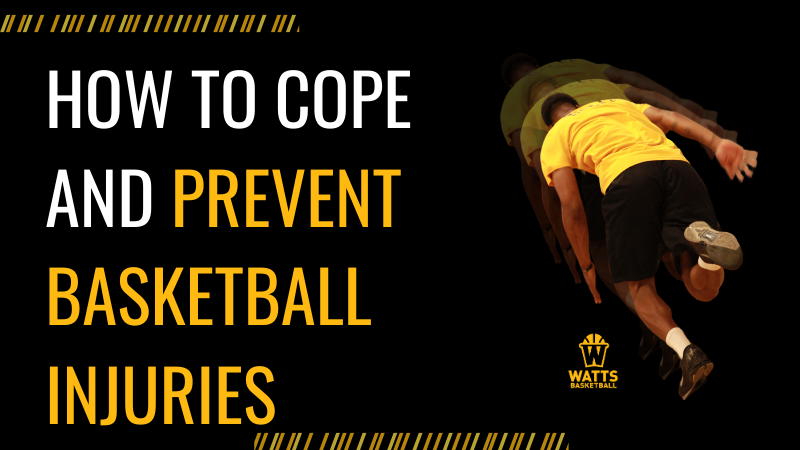Basketball is a physically intensive, fast-paced game, and like any other sport, it has its fair share of risks that will affect the players at one point or another. Risks come in the form of injuries, and this can range from minor to major types. Not only will different types of sports injuries affect your gameplay in the court, but also imagine the productivity lost getting benched for some time. As an athlete, you need to know how to lessen the risk of them happening and ways to cope when injured. Read on to know how to deal with basketball injuries.
Ways to Prevent Basketball Injuries
Prevention should be the primary way to deal with common injuries in basketball and any other sport. Cliche at it may sound, but the saying, “Prevention is better than cure,” is 100% true. Here’s a comprehensive list of how are basketball injuries prevented
Warm-up and Cool Down
Before you begin playing, it is vital for you to warm-up. Stretching and warming up pumps oxygen to your muscles, improving blood flow, slowly increasing your heart rate, helping lessen injuries and stress to your body. Don’t forget to cool down after playing so you can decrease your heart rate slowly. Stopping abruptly can make you dizzy and lightheaded.
Wear Proper Attire
Choose the right basketball shoes of your size, have high tops, and have non-slip soles. Make sure that it fits you well, not too tight and loose. Wear knee pads, mouthguards, ankle braces, compression layers, and support tapes to prevent basketball injuries.
Dress to play. Prepare your basketball jersey, shorts, compression shirt ahead of training and playing. Airy and non-binding clothes will help you move freely and breathe well. Choose fabrics such as polyester for ample absorption and drying of sweat. Avoid wearing jewelry as this may result in injury not only to you but other players as well.
Know your Limit
Once you feel pain, it’s time to stop and take a break. Having pain is your body telling you that something is wrong. Always be in tune with your body so you can prevent basketball injuries. Repetitive movements or overuse of particular body parts can cause damage to your muscles, tendons, and joints. Make sure not to overdo it. Gradually ramp up your training and reduce when you are experiencing discomfort. Burn-out will lead to longer healing times, preventing you from maximizing your productivity.
Have yourself checked
Before the start of the season, seek physical examination to know if your body is fit and healthy enough to play. Get recommendations from your doctor on the best practices you can do to play efficiently and proper basketball injury prevention.
Check the Court
Ensure that the court is free of hazards, dry, and ready for playing. Failure to check the area’s condition can lead to slips, trips, and falls that are some causes of sports injury. Be updated on the weather and temperature in the area to adjust your attire to avoid heat stress and other temperature-related issues that can affect your play.
Stay Fit, Condition, and Adapt Training
One of the best ways to prevent basketball injuries is to condition your body weeks before you play. Give focus on drills and exercises that will improve your agility, endurance, flexibility, and strength. Your progress must be gradual, and adapt your training as your body gets used to the conditioning you are doing. Proper preparation and staying fit will help reduce the risk of injuries.
How to Cope when Injured
Now, what will you do when the unfortunate thing happens? Pain is the main side effect an athlete will have when injured. To ease pain, the primary and golden rule to follow is the R-I-C-E method, which stands for
- R-Rest the injured area for 2-3 days.
- I-Ice the painful parts for around 20 minutes, 5-8 times a day. This way, you can reduce the swell and bruises.
- C-Compress using a clean bandage to ease swelling. Don’t wrap it too tightly.
- E-Elevate the injured area above the level of the heart, mostly when resting.
When athletes are badly injured and require a long healing process, it can lead to negative psychological issues, particularly stress, anxiety, isolation, and depression. It is best to work with your coach, parents, doctor, and therapist to deal with these mentally challenging times. They are your best support network because they have the right tools and methods to help you adjust and cope with all these negative feelings.
Try to stay positive during these times. Rest and don’t pressure yourself too much. If rehabilitation is part of your treatment, take it day by day and celebrate each progress as one step closer to playing basketball again. Always remember that your mindset will have a significant effect on your healing. Use positive imagery and affirmations to lessen these issues.
Don’t rush into going back to the court when you aren’t fully recovered yet. Rushing into it will cause reinjury or more severe damages to your body. Before returning to play, check with your therapist or doctor to go back and acquire the necessary clearances if needed. As you resume playing basketball, take it slow and gradually bounce back to your pre-injury state. Additional protective gear, tapes, and paddings will help you prevent basketball injuries from coming back.
Preventing Injuries Plays a Big Part in Basketball Training
Injuries are part of the game but taking necessary precautionary measures will aid in preventing it from happening. Keep in mind that dealing with basketball injuries takes time, commitment, and learning. Prevent basketball injuries by having mindfulness all the time. Be aware of your body, your movements, and the people you are playing with. Take prevention of injuries as part of your basketball training towards a successful career as an athlete.

